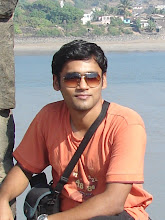My first post of the many to follow - on Durga Puja celebrations in Kolkata.
First, a brief sojourn through the Indian mythology -Mahisasura was a demon who received a boon from Lord Brahma, the creator of the worlds. Empowered with it, he cannot be killed by any man or any deity. Thus, he raged war in all the worlds and also marched into the kingdom of Gods. He defeated Indra, the king of Gods. Defeated and humiliated, all the Gods went to Indian Trimurti (Trinity)- Brahma, Vishnu and Shiva.
These Supreme Gods created Durga with light and energy from their eyes. She was graced with extreme beauty and topped up with immeasurable energy and strength.
 Her face was from light of Shiva, her multiple hands were from Vishnu and legs were from Bhrahma. She also received many other powers - Shiva gave a trident with a spear-end. Krishna gave her a rotating disc. Varuna, the God of sea, gave her a conch and the God of fire gave her a missile. From the wind, Vayu, she received arrows. The king of Gods, Indra, gave her the thunder-bolt. From Yama, the god of death, Durga received a rod, and from the Ruler of Waters she was given a noose. God of mountains, Himalayas gave her jewels and a magnificent lion to ride into battle.
Her face was from light of Shiva, her multiple hands were from Vishnu and legs were from Bhrahma. She also received many other powers - Shiva gave a trident with a spear-end. Krishna gave her a rotating disc. Varuna, the God of sea, gave her a conch and the God of fire gave her a missile. From the wind, Vayu, she received arrows. The king of Gods, Indra, gave her the thunder-bolt. From Yama, the god of death, Durga received a rod, and from the Ruler of Waters she was given a noose. God of mountains, Himalayas gave her jewels and a magnificent lion to ride into battle.Thus, this feminine power rode to battle and defeated Mahisasura in a fierce battle. Mahisasura took the form of a buffalo and charged at her. She beheaded the animal, from which Mahisasura emerged in his demonic form. She pierced his chest with the trident and killed him. She has since then been known as MahisasurMardini (Killer of Mahisasura).

Durga Puja is also linked with Ramayana. During the battle between Ram and Ravana, Ram wanted a boon from Devi Durga. He came to know that she can be pleased with an offering of 100 blue lotuses. With much difficulty, he can only gather 99 of them. Finally, he decided to give one of his eyes - they resembled blue lotuses. Much pleased by this, the goddess blessed Ram. The final battle between Ram and Ravana started on the "Saptami" - Seventh Day. Ravana was killed between the "Ashtami" and "Navami" - Eighth and Ninth Day. He was cremated on "Dasami" - the tenth day. Thus, Durga Puja is also known as Dussehra and is celebrated with much pomp and show for four days - signifying the four days of the battle.
In India, Dussehra is a major festival for Bengalis. And Kolkata is the place to be during these four days. There are innumerable Durga idols dotting the city's avenues, streets, by-lanes, housing complexes and societies.
I hope you all will enjoy all the posts that will try to capture this festival in Kolkata.



3 comments:
Amazing.... loved this one
kitna gass marta hain.. :)
its simply awesum :D
Post a Comment